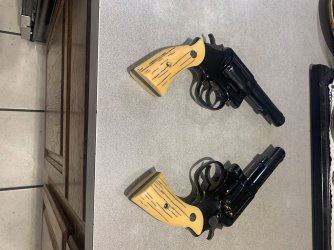- Joined
- Oct 21, 2021
- Messages
- 273
- Reaction score
- 432
I've had this .22 Combat Masterpiece pre 18 4 screw (1957?) for 40 years. K315xxx. It has correct # grips and is in beautiful shape but it has always been a shooter. I reamed the cylinders assembled years ago to stop knocking out the empties with a block of wood. It has never allowed me to disassemble the extractor section as it has been cross threaded or mis- matched threads. I've given up trying to unscrew the extractor and rod and as there was a thread change about this time and the correct parts are just not around anymore. Is there someone with the parts and knowhow to repair his thing. I'm in N. Calif. My favorite gunsmith Andy Anderson from Cinnabar Rifle shop in Petaluma is long gone and I just don't trust any of the local new kids to take it on. It needs someone who understands the thread and direction change and has the vintage parts.
Thanks
D
Thanks
D


